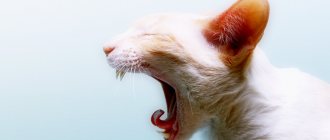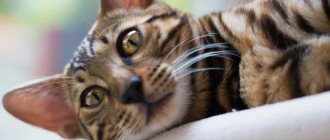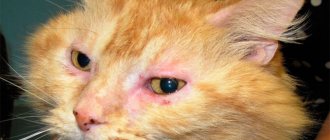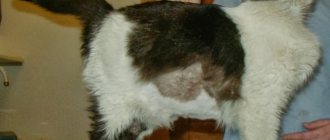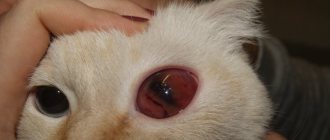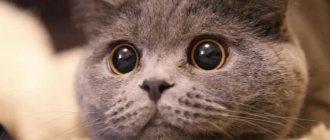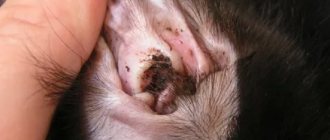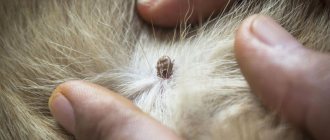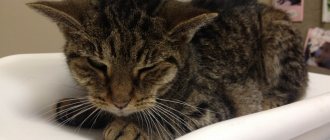Causes
Skin lesions of the neck occur for the following reasons:
If the cat is itching, but there are no fleas or they have recently been expelled, the cause of the disease should be looked deeper. Skin scrapings may reveal hypodermal mites. Most often, Demodex and Notoedrus are found in cats.
Before applying medications to the affected area of the neck, the hair is cut to open access for the action of the medications and to monitor the cat’s condition over time. Treatment of the disease is carried out using the following groups of medications:
- Symptomatic.
- General strengthening
- System
Symptomatic remedies are put in front because if the diagnosis is unclear, one cannot waste time allowing the development of the pathological process. These are external, cleansing skin from scabs and anti-inflammatory agents in the form of ointments, gels or aerosols. Complex systemic preparations that have acaricidal, antimicrobial, antimycotic, and anti-inflammatory effects are moistened onto the prepared surface.
At the same time, medications are used that increase immune defense
Allergic reaction
The second most common cause of hypersensitive reactions after flea dermatitis is food allergy. If this type of pathology is suspected, diagnostic procedures are combined with therapeutic ones. Finding out which component causes dermatitis is a difficult task. Therefore, the animal is given hypoallergenic food, while simultaneously undergoing desensitization therapy with medications containing Dexamethasone. When improvement occurs, restorative drugs and immunomodulators are prescribed. It may take months for you to fully recover.
Another type of allergy, atopic dermatitis, develops against the background of an innate predisposition to violent reactions to irritants. Such a cat is excluded from breeding.
The disease is incurable, but methods that can minimize complications have been developed. In addition to symptomatic treatment, the cat is isolated from the irritant. If there is a suspicion of hypersensitivity, the substances with which the flea collar is impregnated are snatched, it is removed. During the flowering of allergenic plants, the cat is not allowed to walk, and the apartment windows are left closed. It is possible that you will have to change the litter in the cat's litter box.
Lichen
Among fungal infections, Microsporia is the most common. The spores are resistant to medications and can cause secondary infection.
Antimycotic drugs are divided into the following drug groups:
- External. Solutions, gels, and ointments are used. To facilitate access to the active substances, six are cut off. Licking is prevented by using an Elizabethan collar.
- Oral. Tablets have severe side effects, so they are used when external medications are ineffective.
- Parenteral. Immunomodulators are used, as well as anti-inflammatory drugs for severe cases of the process.
For weeping eczema, drying agents are used, and dry eczema is treated with moisturizing external medications. The acute course requires the use of analgesics, as well as steroidal antiphlogistics. The composition of ointments includes antimicrobial agents. The use of immunomodulators speeds up the healing process.
Owners often ignore the appearance of black spots on their pet’s chin: “Just think, acne in cats is quite common and is not dangerous.” However, if you dig deeper, it turns out that blackheads and pimples on a cat's chin can be a sign of a number of diseases or the result of improper care. Why do acne appear on the skin of some pets and how to treat acne in cats?
In advanced cases, acne and pimples in cats are visible not only on the chin, but also on the inner thighs, on the elbows, around the genitals and anus, between the fingers. If these are not individual points, but scatterings of crusts and ripening ones, be sure to contact your veterinarian.
Blackheads are oxidized plugs that clog skin pores. Most of the plug is made up of sebum produced by the sebaceous glands. When the sebaceous gland begins to overproduce sebum, acne appears in cats (just like in humans).
Why do acne appear on a cat's chin and not in other parts of the body? The fact is that the more hairs per centimeter of skin, the fewer sebaceous glands in this area and the less developed they are. And on the chin the hair is usually sparse and short. In addition, the chin constantly becomes dirty while eating, and the cat cannot wash it thoroughly, which contributes to disruption of the functions of the sebaceous glands. Therefore, acne in cats rarely appears on other parts of the body - the cat is carefully licked, removing the accumulated layer of contaminated sebum.
However, pollution is not the only cause of acne. For example, if a cat develops acne on its body even with proper care, heredity may be to blame - the sebaceous glands work excessively from birth, which is an individual feature and cannot be treated, but is controlled by hygiene products. In addition, acne on a cat’s chin can appear as a result of improper feeding, hormonal imbalance, liver or gastrointestinal disease, disorders of the central nervous system, autonomic and immune disorders.
Black spots and pimples on cats' ears are a consequence of insufficient care. Normally, earwax is produced in limited quantities and does not interfere with the normal functioning of the sebaceous glands. But the ears of some pets need regular cleaning due to the rapid accumulation of wax - this is also an individual feature inherent in individual individuals or breeds (for example, hairless and curly-haired cats, pets with large “open” ears). Sometimes acne in cats' ears appears due to excessive grooming, when owners maniacally clean the surface of the ears - the glands, trying to make up for the “losses” and restore the protective layer, begin to work with a vengeance.
Recently, skin diseases have become widespread in cats, from which, according to statistics, every third pet suffers. Often, problems with the skin are the result of some internal pathology that requires immediate treatment. Many skin diseases pose a danger not only to the cat, but also to the owner, so it is extremely important to promptly recognize the disorder and begin treatment.
Treatment
Before you begin treating your pet at home, you should visit a veterinary clinic for an accurate diagnosis. First of all, the doctor excludes the presence of parasites and fungal infections. Be sure to scan the cat's ears with a special lamp, which is used to diagnose lichen.
Common acne associated with wound infection is treated with antiseptics and antibacterial ointments. I treat the rash several times a day with peroxide or chlorhexidine, or you can use a weak solution of potassium permanganate. Additionally, either Levomekol or Vishnevsky ointment is used.
An abscess on a cat's ears must be opened. If it opens on its own, there is a risk of ear infection, which can have negative consequences for the animal's health. The doctor makes a puncture in the abscess, then carefully cleans the cavity and applies a bandage with an antibacterial drug to the wound. In some cases, your pet may be given antibiotic injections to prevent further infection.
The lipoma must be removed. In this case, pieces of removed tissue are sent to the laboratory for histological analysis. This is necessary to exclude the malignant nature of the neoplasm.
If the rash is caused by parasites, measures must be taken to get rid of fleas and ticks. Doctors usually prescribe special drops. It is important to choose a drug that will not cause an allergic reaction in the cat. After antiparasitic treatment, acne is regularly washed with an antiseptic; other measures, as a rule, are not required.
List of skin diseases in cats
There is a whole spectrum of skin diseases that are diverse in nature and manifest themselves in completely different ways. Skin lesions can be caused by a variety of reasons - hereditary, anthropogenic, infectious; even a simple change in diet can cause rashes on the body.
Attention. We should not forget that fleas are carriers of helminths and can infect an animal through a regular bite. Therefore, along with treatment for fleas, the animal should be dewormed in a timely manner.
Diagnostics
The cause of the disease is determined taking into account the medical history, clinical symptoms and additional studies. If the presence of ectoparasites is able to be detected by the cat’s owner, then only an experienced veterinary laboratory technician can identify the tick by microscopy of a skin scraping. In doubtful cases, diagnosis and treatment are used. If the drug used against the suspected disease does not work, the version is rejected, narrowing the list of reasons. A mandatory diagnostic and treatment test is the use of ready-made hypoallergenic food.
The skin scraping material can be cultured and the pathogen can be determined by the type of colony that has grown. Illuminating the pathological area with a Wood's lamp will allow us to establish the mycotic cause of the disease. The doctor may prescribe a blood biochemistry study and an ultrasound of internal organs.
Eczema
Ringworm
Ringworm is an infectious fungal pathology that often affects young animals with reduced immunity, as well as cats that have suffered from cancer or viral diseases.
The cause of the disease is fungal spores, which can be carried on clothes or shoes. Infection occurs through contact with a sick animal, through shared toys, feeding and care items.
Clinical signs of ringworm are:
- bald areas on the head, tail and limbs;
- in the center of the affected area, the skin turns red and peels, sometimes ulcers, white scales and crusts appear.
Treatment of the disease is carried out using antifungal ointments and antiseptic solutions. In severe cases, antibiotics, vaccines and oral antifungal medications are prescribed.
Useful video
All types of skin diseases:
Miliary dermatitis is called eczema and even cat mangy.
This is a common cat disease.
Veterinary dermatologists prefer to call this condition a special skin reaction. Indeed, these are symptoms of many diseases. Cat skin has a limited number of options for responding to different disease conditions. A small rash that feels like sandpaper and is accompanied by itching
is not a disease, but a symptom of a disease.
Miliary dermatitis is a scattering of small pimples, or nodules, on the skin, localized or covering the entire body. Typically, these pimples crust over and turn into scabs that can be easily felt through the cat's fur when you pet your cat. The term “miliary” means “millet-like” - the nodules feel like grains of millet to the touch.
Such as can also cause miliary dermatitis. Even bacteria, immune disorders, reactions to medications and digestive problems can manifest as crusts on the skin. One in six cases of miliary dermatitis is idiopathic
- this means that the cause cannot be determined. To cure this skin condition, you need to identify its cause and eliminate it.
Establishing diagnosis.
The location of the rash on the body can often provide an indication of its cause. If the rash is on the head and neck, then most likely it is a food allergy. If the base of the tail is affected, it is most often a reaction to fleas. If a rash is noted throughout the body, doctors suspect respiratory allergies or atopy. Flea allergies and atopy are seasonal phenomena, while cats suffer from food allergies all year round.
Treatment of miliary dermatitis
begins with a series of tests aimed at identifying the cause of this condition. Probably the most common culprits are . Since even one flea bite causes an allergic reaction, and cats themselves lick themselves zealously, it can be difficult to detect traces of fleas in a cat’s fur coat. You can suggest this way of checking for fleas: you scratch-scratch-scratch the cat's coat and put all the combed dirt on a wet white cloth. If it is flea excrement, then the black specks turn red.
Respiratory allergies are often caused by pollen, mold and indoor dust.
, and diagnosing it requires intradermal testing. Suspected allergens are placed inside the skin (not under the skin) by scratching a shaved area of the cat's skin, which has previously been given a sedative. In the case of a positive reaction, the scratch swells and becomes redder after 5-15 minutes; in a negative reaction, there is no inflammation.
If miliary dermatitis is a food allergy, the rash will persist as long as the cat is exposed to that type of food. To diagnose a food allergy, a cat is put on a diet that includes ingredients it has never eaten before. If symptoms disappear, then some component of the old diet is to blame for the disease. These old components are added one by one to the new diet and monitored which one will cause an allergic reaction. This diagnostic feeding can last up to 12 weeks and should be done under medical supervision.
Miliary dermatitis in the armpit
Otodectes cynotis, known as Otodectes cynotis, can also cause miliary dermatitis on the head and neck. About three percent of cases of miliary dermatitis are caused by ear scabies.
Demodicosis, rare in cats
, known as the iron bug and is caused by the mite Demodex cati, which lives in the hair follicle (hair follicle). It can also cause miliary dermatitis.
Cats suffering from head lice
, that is, those infected with the lice-eater Felicola subrostratus, or chewing louse,
may also have signs of miliary dermatitis
.
Treating itching is not treating the disease.
If you use standard allergy treatment, the symptoms of miliary dermatitis may be relieved, but they will return if this treatment is stopped. It is necessary to constantly monitor the presence of fleas in a cat if she is allergic to fleas. There are a huge number of products available on the market for the safe removal of fleas both from a cat and from its surrounding home environment.
The best therapy for respiratory allergies, according to experts, is frequent bathing of the cat: in this case, you wash off the allergen from its fur. A mild shampoo that does not dry out the skin or simply rinsing the cat with clean water is suitable for this. Some cats susceptible to atopy benefit from immunotherapy. Once the causative agent of the allergy is identified, the cat is given a series of injections of a drug based on this allergen in order to increase the resistance of the animal’s own immune system. Results appear slowly, and treatment usually lasts a year or more. Maintenance, preventive injections can be repeated periodically to make the cat feel more comfortable.
Miliary dermatitis caused by food allergies goes away as soon as you can find a suitable diet.
Many hidden causes of dermatitis can be treated well with cortisone.
Steroids and antibiotics are prescribed to relieve severe itching or kill infection.
But the diagnosis of the root cause of dermatitis is very important; there is no point in treating itching by itself.
The painful condition may worsen if ringworm is treated with cortisone. Modern therapy for ringworm should include the use of a new vaccine against Microsporum canis in combination with medical baths, local ointments and environmental disinfection.
Blackheads appear in cats due to blocked sebaceous glands. The plugs, consisting of dirt, germs and fat, clog the pores. Inflammation begins and pustules form. At the initial stage, acne covers only the chin and nose of the animal. If acne is not treated, the rash spreads to the stomach and tail. Inflamed pores fill with pus, increase in size and cause discomfort to the pet.
Acne
Acne is an acne disease characterized by the formation of closed and open comedones, most often on the chin.
The reasons for the development of acne can be improper care of the cat, stress, infectious pathologies, abnormal development of the sebaceous glands and hair follicles. Visually, the disease is manifested by the presence of black or white spots, partial hair loss, and an increase in hard crusts. Acne can progress to painful ulcers and ulcers, which can cause inflammation and bacterial infection.
Treatment of acne consists of treating with antiseptic and antiseborrheic soaps and shampoos (for example, tar), applying antiseptic solutions (Chlorhexidine, Miramistin, etc.). In advanced cases, antibiotics and corticosteroids are used.
Acne Care
Skin covered with rashes or pustules is washed daily using special shampoos. Gels designed to treat teenage acne, tar soap or shampoo are suitable. The correct cosmetic product that will remove blackheads should contain:
- sulfur;
- salicylic acid;
- ethyl lactate;
- benzoyl peroxide.
Lactaderm and Doctor shampoos are suitable. They normalize the functioning of the sebaceous glands and dry out the pet’s skin.
Cosmetics are applied only to areas affected by acne. Shampoos are rubbed with cotton swabs on the chin or mustache to soften acne. The remaining foam is removed with wet gauze, wiped with a damp towel, and then a piece of dry cloth is applied so that it absorbs the remaining liquid.
After hygiene procedures, the inflamed epidermis is wiped with a cotton swab dipped in antiseptic. A cheap option is peroxide. You can use Chlorhexidine or Miramistin, treat the skin with lotions for teenage acne or pharmacy calendula tincture.
Alcohol-containing products are applied carefully. The antiseptic should not come into contact with healthy skin or mucous membranes. The substances cause irritation and leave burns. Boils after bathing and treatment with antiseptics can be steamed. Apply a clean cotton napkin soaked in hot water or chamomile infusion to acne filled with pus. Steamed rashes are wiped with salicylic acid. The drug removes inflammation and dries out acne, draws out pus and disinfects the epidermis.
Antiseptics are combined with moisturizing ointments. Alcohol-containing products dry out the skin. The sebaceous glands begin to work more actively, secreting more oil, which clogs the pores. They become inflamed and ulcers form. To prevent this from happening, nourishing ointments for acne in cats are rubbed into the disinfected skin.
Suitable:
- salicylic or sulfur ointment;
- Flucinar;
- Linemet syntomycin;
- zinc ointment;
- Percutan;
- tetracycline or erythromycin ointment;
- Levomekol;
- Yam ointment
The drugs dry out rashes and remove ulcers. Belosalik cream helps, which is applied pointwise. Soak a cotton swab in the product and lubricate areas of skin covered with acne.
You need to wait 30–40 minutes until the drug is absorbed. Residues are removed with a cotton swab. The cat should not be allowed to lick the medicine, otherwise the animal may be poisoned. The selected ointment is applied in a thin layer. If you use too much product, it will clog your pores and worsen your skin condition.
Bacterial infections
Bacterial infections occur in two forms: dry and wet. In the first case, dense formations and crusts appear on the skin. The second form is characterized by the presence of areas of skin with severe hyperemia and moisture, which is accompanied by a rash, ulcers, itching and crusts.
To understand the form of the disease in your pet, you need to not only read the description of the disease, but also carefully study the photo.
There can be a huge number of reasons for a bacterial infection:
- allergies accompanied by itching;
- heredity;
- stress;
- violation of metabolic processes;
- presence of shallow wounds;
- diabetes mellitus, tumors, kidney damage, etc.
Treatment is based on the use of antibiotics and local drugs (Miramistin, Levomekol, aluminum and zinc-containing ointments).
Bacterial skin diseases include.
Seborrhea dry and oily
If your pet suddenly starts smelling like a dog, so much so that it becomes difficult to be in the same room with the cat, do not rush to accuse him of being unclean. It is possible that your pet suffers from seborrhea. This is a disease characterized by impaired sebum secretion. If too much of it is secreted, then seborrhea is, accordingly, called “oily.” With insufficient secretion of sebum, a dry type of the disease develops.
Veterinarians are still arguing about the causes of the disease, but to this day many cases must be considered idiopathic, since not a single study has helped to identify a single predisposing factor. In cats, the most common is the “fat” variety.
The clinical picture is quite characteristic. In addition to the unpleasant odor already mentioned above, numerous dandruff appears on the animal’s skin and fur (with the dry variety), or the cat’s tail resembles an unsightly icicle. In the latter case, this happens because the sebum released in incredible volumes simply sticks the hair together.
The intervals between relapses (with proper feeding and good living conditions) can reach several months.
The main predisposing factors are:
- Temperature changes, as well as keeping the cat in rooms with excessively dry air (which is typical for all apartments with central heating).
- It is believed that one of the main reasons for the development of seborrhea in many cases is a variety of allergic reactions.
- The same can be said about diseases of fungal etiology. Pathogenic fungi and yeast have a very bad effect on the condition of the skin.
- “Raw” or “oily” seborrhea is a common consequence of severe hormonal disorders. In particular, it often appears with problems with the thyroid gland.
- Obesity. Firstly, in cats it can also be a consequence of problems with the endocrine glands. Secondly, a “swollen” cat is simply physically unable to take proper care of itself, which makes it much easier for pathogenic fungi to invade its skin. In addition, in such cases, the animal may not have seborrhea, and greasy skin is only a sign of its extreme neglect.
- Diseases of the gastrointestinal tract. If the body does not receive the proper amount of nutrients, micro- and macroelements, the likelihood of developing any diseases becomes many times higher.
- Skin diseases of tick-borne etiology. As a rule, the activity of these parasites leads to the development of a dry type of the disease: mites, gnawing through the outer layers of the skin and actively developing in them, interfere with the normal functioning of the body.
Symptoms and treatment
The symptoms are quite specific, and therefore, as a rule, there are no particular difficulties in identifying the disease. First of all, it is the tail that is affected, which as a result either becomes covered with dandruff, or takes on the appearance of a “greasy icicle.” Abundant dandruff rashes can be found in places where the animal likes to rest; they also become heavily greasy in the case of the oily type of pathology.
Another characteristic sign is very specific, sharp and extremely unpleasant. Experienced owners or veterinarians are able to make a diagnosis as soon as they smell this “aroma.” Note that seborrhea itself does not produce any odor - it is a consequence of the activity of secondary microflora.
As for treatment, it is primarily aimed at eliminating the identified root cause of the disease. Idiopathic seborrhea is treated with special shampoos, which can be purchased at any large pet store. We would recommend consulting with your veterinarian first. It is better when the shampoo is selected by an experienced specialist.
The following products have proven themselves to be effective:
- "Tea tree". It degreases the skin well and has a pronounced anti-inflammatory effect.
- Additionally, any antiparasitic shampoo. It is used in cases where the disease is caused by the activity of fleas, ticks, or other ectoparasites.
- Accordingly, when the disease is fungal in nature, shampoos with an antifungal effect are used.
Allergic skin diseases
Allergic reactions are a consequence of an inadequate response of the cat's immune system to foreign substances entering the body. The cause of an allergy can be anything: a certain component of food, household chemicals, plant pollen, synthetic fabrics, dust in the house, etc. When exposed to an allergen, skin hyperemia, inflamed areas, severe itching, hair loss and increased body temperature are observed.
Important. Long-term exposure to an allergen is fraught with the development of atopic dermatitis, eosinophilic granuloma and asthmatic syndrome.
Therapy for allergic reactions includes taking antihistamines to relieve itching, hormonal agents and antibiotics if urgently needed. To alleviate the pet's condition, medicated shampoos and decoctions of medicinal herbs are used.
What causes wounds on a cat's neck?
The causes of skin diseases in cats are different, but “uninvited residents”, that is, fleas, can become irritants. To exclude this possibility, you should bathe your pet by treating it with a special shampoo.
No flea collars should be worn; they can irritate the skin. If the fleas are removed, but the problems remain, you need to evaluate the general condition of the body.
Symptoms of skin diseases in cats at the initial stage are as follows:
First of all , if a cat has wounds on the neck, you should think about the pet’s diet. They, like people, are susceptible to food allergies. Congenital predisposition is recorded by veterinary statistics in white cats.
To replenish the supply of vitamins, you need to grow oats in a tray and feed the cat grass.
If your pet constantly eats store-bought food, there is a high probability of disruption of the internal organs. The cat should be switched to natural food: boiled fish (cleaned of bones), fish soup without salt, boiled meat and, as a delicacy, lightly boiled liver (1-2 minutes).
Can you help your pet yourself?
Mostly, redness and sores on a cat's neck are accompanied by peeling and crusting. For a few wounds, it is recommended to purchase medical sulfur from a pet store and add it to your pet’s food (on the tip of a knife) for 14 days. Fertilizing with sulfur is also carried out for preventive purposes in the spring and autumn.
If the transition to proper nutrition has been made, 10-14 days have passed, and there is no improvement, it is time to consult a veterinarian, because the allergy may be atopic in nature. Then the allergic reaction may be provoked by house dust mites, spring flowering or other environmental factors.
Popular Symptoms of cystitis in a cat: treatment and prevention
Diagnostic and therapeutic measures
The next possibility is the presence of an infectious or parasitic disease: skin mites (for example, demodex) or fungal diseases. In this case, the clinic offers the following tests:
- A general blood test to check for the presence of an inflammatory process.
- Scraping from the surface of the wound to determine the type of mite.
- Smears are impressions from the surface of the wound. They are studied under a microscope to determine the type of pathogen: fungi, bacteria, etc.
- Plucking and examining animal hair under a microscope.
- Luminescent diagnostics – detects some types of fungal diseases.
- Tissue culture is used for more severe symptoms.
Medical treatment of all types of skin diseases, including if a cat’s neck wound does not heal, requires an integrated approach.
Antihistamines are prescribed (to reduce itching), antibiotics to remove secondary microflora for 10-21 days, local preparations in the form of ointment, lotion, cream and medicated shampoos (based on chlorhexidine or antifungal components) for bathing 1-2 times a day. week. A 1.5-2 month diet will be a must.
Under no circumstances should “human” medications be used in pediatric dosages. When treating pets, the dose of the drug is specific and is calculated by a veterinarian based on the weight of the pet and the type of animal. A different dosage may worsen the situation.
The last and more typical occurrence of a wound on a cat’s neck is the pet’s pugnacity. In the heat of mating season or during the development of territories adjacent to the house, cat fights are very common. Naturally, after battles, the cat trudges back hungry, exhausted and wounded. If blood oozes out of the wound, you should immediately contact a veterinarian.
The risk of losing a pet from bleeding is very high.
In case of only skin injuries without blood loss, you can help yourself. Proceed as follows:
- disinfect the wound with 3% hydrogen peroxide;
- treated with Chlorhexidine solution for 5-7 days;
- Levomekol ointment is applied to the wound;
- the wound should be bandaged or a veterinary collar should be purchased, since cats often lick their wounds, and there is nothing useful in their saliva. This will only interfere with healing.
Popular Why doesn't my cat drink water?
Wound treatments are carried out twice a day: morning and evening. If the wound is extensive, you should contact a veterinary clinic for antibiotics and suturing of the wound.
In conclusion, we note that if it is impossible to help your pet on your own, you should not waste time and money in contacting a specialist. Only a doctor can prescribe tests and make the correct diagnosis. Don’t forget: “We are responsible for those we have tamed.”
Source: https://KozhaKoshek.com/ranki-na-shee-u-koshki.html
Atopic dermatitis
Atopic dermatitis is a chronic inflammatory disease of the skin caused by allergens from the environment. The cause of this disease is the body’s increased reaction to certain substances (mold, pollen, household chemicals, certain foods, dust, etc.).
Atopic dermatitis has the following clinical picture:
- severe itching and, as a result, scratching;
- skin rash;
- hair loss;
- when infection gets into the wound, pustules form;
- affected areas are in the head, ears, neck or chest, lower abdomen and between the thighs.
To prevent the development of infection, broad-spectrum antibiotics and antimicrobials are prescribed, and to eliminate signs of allergy, standard antihistamines (Chlorpheniramine, Clemastine) are prescribed.
Infestation by exogenous insects
Both fleas and other bloodsuckers can parasitize a cat’s body . The presence of these insects leads to the occurrence of various diseases. The most dangerous of them include:
- flea dermatitis;
- mite damage: sarcoptic mange, notoedrosis.
When a flea bites, a wound with their saliva remains on the animal's body, causing severe itching. The cat begins to vigorously scratch the affected area, which leads to the infection getting inside. The inflammatory process in combed areas is manifested by redness and hair loss.
When infected with ticks, the clinical picture in cats is as follows::
- severe itching on dry areas of the skin;
- hair loss;
- formation of ulcers on exposed areas.
Notoedrosis in cats is manifested by the presence of Notoedres cat mites and is accompanied by the following symptoms:
- itching and severe scratching;
- rash in the form of blisters;
- the appearance of crusts on itchy areas;
- hair loss;
- loss of skin elasticity, appearance of cracks infected with bacteria and fungi.
Sarcoptic mange occurs in cats due to their infestation with mites of the species Sarcoptes canis .
These tiny bloodsuckers are 0.2-0.4 mm long and have a long proboscis. Thanks to this, they easily gnaw holes in the skin and make a large number of moves in it. Once on the animal's body, the parasites begin to actively lay larvae. In this regard, already 1.5 months after their appearance, their numerous offspring are present on the cat’s body. The main symptom of this disease is severe itching, which gets worse in the evening. First of all, the tick infects areas on the animal’s head, neck, and near the ears, where blisters and redness immediately appear. After a while, these places become covered with dried crusts. The animal becomes restless, constantly itches and meows. Constantly scratching itchy areas, the cat cannot sleep, loses its appetite and experiences weight loss.
Therapy involves not only getting rid of bloodsuckers, but also healing damaged skin areas, as well as restoring the pet’s immune system.
Demodicosis
Symptoms of demodicosis include:
- the formation of dense tubercles on the pet’s body, when pressure is applied to them, white clots are released;
- constant scratching and skin rashes;
- redness of the affected areas;
- partial baldness;
- presence of red crusts;
- formation of pustules during the duration of the disease.
Attention. It is this skin disease that most often leads to death.
How to use folk remedies?
Traditional medicine recipes can give good results in care; they are suitable for treating wounds. A piece of pumpkin
You can lightly wipe the rash areas.
A solution consisting of a decoction of chamomile and calendula is suitable for lubricating the affected areas.
and two tablets of furatsilin.
For acne in cats, you should try treating areas with rashes with a decoction of yarrow and celandine.
.
Sulfur ointment is known for its bactericidal effect.
, it must be applied in a thin layer, pointwise, without rubbing.
To prevent the cat from licking the drug, you should put a special collar on it. Clotrimazole is also applied spotwise to acne
.
Ear mite
The progression of the disease is fraught with inflammation of the outer ear, which can spread to the middle ear, which in turn is dangerous for imbalance. In such a situation, the animal will constantly keep its head to one side. Sometimes the infection reaches the parotid space, causing severe inflammation.
Treatment of ear mites includes systematic cleansing of the ear canals and the use of acaricidal drops.
Find out more about the common disease -.
Psychogenic alopecia
Alopecia is the rapid loss of hair. The cause of psychogenic alopecia in domestic cats is neurosis that occurs as a result of environmental changes (change of residence, new owner, appearance of a new family member or pet in the house, etc.).
Most often, this disease occurs in emotional breeds: Siamese, Himalayan, Burmese, Abyssinian, but it also happens in completely outbred individuals. Externally, the disease manifests itself as baldness in the groin area, abdomen, sides and inner thighs, along the dorsal midline. There is no redness or crusts on the bald areas.
In the treatment of psychogenic alopecia, the main thing is to eliminate or minimize stress. Among the medications, behavior-correcting drugs have proven themselves: Amitriptyline, Cat Bayun or Stop Stress.
The danger of skin pathologies for humans
Despite the fact that such diseases are an unpleasant phenomenon, most of them are not transmitted to people. Timely and correct prescription of medications makes them not dangerous for their owners.
Infection with different types of lichen and allergic reactions from blood-sucking bites require the use of medications not only for the animal, but also for the owner. They do not pose a threat to life, but the spread of scabs and ulcers throughout the body of a person or pet is not a very pleasant phenomenon, and it needs prompt treatment.
Cushing's syndrome
Cushing's syndrome (or hyperadrenocorticism) is an extremely rare disease that develops as a result of excessive amounts of the hormone cortisol in the body. Excess cortisol can occur with the use of large amounts of corticosteroids orally, locally or by injection, with tumors of the adrenal cortex, and also as a result of pituitary gland disease.
The following phenomena are observed in Cushing's syndrome:
- increased thirst and increased urination;
- voracity;
- enlarged abdomen;
- amyotrophy;
- lethargy;
- hair loss;
- thinning of the skin.
In the treatment of this serious disease, as a rule, the drug Trilostane is used, which suppresses the production of cortisol. In some cases, removal of the adrenal gland or pituitary gland may be necessary, as well as radiation therapy to the pituitary tumor.
A little theory
Acne, or blackheads as they are also called, is the result of blockage of the sebaceous glands.
These glands constantly produce sebum, which is necessary to moisturize the hair and maintain skin elasticity. The greatest accumulation of glands is observed in the chin area, on the lips, root of the tail, eyelids, as well as the external genitalia of males (foreskin and scrotum).
The external secretion organs secrete an oily liquid with a specific odor. It serves as a kind of marker of personal space. Everyone has repeatedly seen how a cat rubs its chin, head and base of its tail against various objects - a way to mark territory and determine its own boundaries of possession.
It is believed that the main cause of acne in cats is overactivity of the sebaceous glands:
- hair follicles produce excessive amounts of oily secretions and keratin (skin protein),
- the secretion does not have time to completely exit through the ducts and clogs them,
- in the end it all ends in an inflammatory process.
Sebaceous gland blockage
In turn, excessive work of the glands is a consequence of the influence of internal or external circumstances on the body:
- hormonal imbalance, for example, acne appears in teenage kittens at the stage of puberty or in male sires with elevated testosterone levels,
- metabolic disorders as a result of obesity,
- malfunction of the liver,
- poor living conditions when owners forget about basic hygiene rules and do not monitor the cleanliness of the skin of their charges.
Who is sick?
In fact, a cat of any breed and at any age can get sick. But according to statistics, the disease is more common in sphinxes and pets with a flat face (Persians, exotics, etc.).
Acne on the tail of Sphynx cats
A characteristic feature of the skin of all hairless breeds is increased sebum production. Over time, fat accumulates on the surface of the body, forming a brown crust. The lack of periodic hygiene procedures leads to dermatitis, the notorious blockage of the glands and the appearance of acne. Most often, a similar phenomenon in sphinxes is observed in the tail area.
For Persians, the typical location for acne is the chin. And this is due to the structural features of the muzzle. Owners of extreme sports dogs are well aware of how dirty this area becomes during feeding.
It was also noticed that sterilized pets suffer from acne much less often than non-neutered ones. But there is no clear relationship, so it cannot be said that sterilization will save the animal from the disease.
Notoedrosis
Symptoms of this disease include:
- severe itching;
- blisters are observed on the face, ears, stomach and groin area, which become crusty after scratching;
- hair loss, often in places where crusts are concentrated;
- as the disease progresses, the skin thickens, dries and cracks - as a result, the wounds open the gates to infections (bacteria, fungi and viruses).
Therapy for notoedrosis includes bathing with acaricidal and keratolytic shampoos, as well as local application of medications (Demos, aversectin ointment, neocidol aqueous emulsion, sulfur ointment, Stronghold).
Owners often ignore the appearance of black spots on their pet’s chin: “Just think, acne in cats is quite common and is not dangerous.” However, if you dig deeper, it turns out that blackheads and pimples on a cat's chin can be a sign of a number of diseases or the result of improper care. Why do acne appear on the skin of some pets and how to treat acne in cats?
In advanced cases, acne and pimples in cats are visible not only on the chin, but also on the inner thighs, on the elbows, around the genitals and anus, between the fingers. If these are not individual spots, but scatterings of crusts and ripening comedones, be sure to consult a veterinarian.
Acne in cats occurs due to a violation of the keratinization process, at the stage of which the formation and desquamation of the upper layer of the epidermis, consisting of dry scaly formations, occurs.
The appearance of acne in a cat is also related to its sebaceous glands, which produce oily secretion - subcutaneous sebum, designed to protect the hair and skin of cats from moisture. The majority of these glands are located in smooth areas and in areas of weak hair covering the animal, in particular on the lips and chin, between the ears, near the eyes, and at the base of the tail.
Acne most often affects cats with a weakened body and type of heredity. Acne develops in all cases where the keratinization process is disrupted in cats. In this case, instead of a single peeling of scales, entire layers of scaly formations are formed, glued together with sebaceous secretions. As a result, there is clogging of the sebaceous glands and the formation of black dots called comedones, which cover the skin around the hair follicles.
Cat acne can be caused by stress, lack of grooming, an allergic reaction to litter, or it can be caused by contact dermatitis and other skin diseases in which there is excess oil production and hair follicles do not function properly. An important role in maintaining the pathological condition is played by constant humidity on the affected area of the skin and infrequent washing by the owners of the animal’s bowl, which leads to the accumulation of bacteria on it.
Most often, this pathology appears on the cat’s lips and chin. It looks like a large accumulation of black dots (comedones) in one place, similar to poppy seeds. Often they do not bother the animal for a long time, but over time they can turn into small purulent inflammations, which, after opening, form crusts. In the event of additional infection of the affected area or as a result of a general weakening of the body of a sick animal, the cat may experience itching at the site where acne appears, hair falls out, and the affected area becomes swollen. If you scratch the itchy area vigorously, there is a risk of secondary bacterial infection.
Blackheads are oxidized plugs that clog skin pores. Most of the plug is made up of sebum produced by the sebaceous glands. When the sebaceous gland begins to overproduce sebum, acne appears in cats (just like in humans).
Why do acne appear on a cat's chin and not in other parts of the body? The fact is that the more hairs per centimeter of skin, the fewer sebaceous glands in this area and the less developed they are. And on the chin the hair is usually sparse and short. In addition, the chin constantly becomes dirty while eating, and the cat cannot wash it thoroughly, which contributes to disruption of the functions of the sebaceous glands. Therefore, acne in cats rarely appears on other parts of the body - the cat is carefully licked, removing the accumulated layer of contaminated sebum.
However, pollution is not the only cause of acne. For example, if a cat develops acne on its body even with proper care, heredity may be to blame - the sebaceous glands work excessively from birth, which is an individual feature and cannot be treated, but is controlled by hygiene products. In addition, acne on a cat’s chin can appear as a result of improper feeding, hormonal imbalance, liver or gastrointestinal disease, disorders of the central nervous system, autonomic and immune disorders.
Black spots and pimples on cats' ears are a consequence of insufficient care. Normally, earwax is produced in limited quantities and does not interfere with the normal functioning of the sebaceous glands. But the ears of some pets need regular cleaning due to the rapid accumulation of wax - this is also an individual feature inherent in individual individuals or breeds (for example, hairless and curly-haired cats, pets with large “open” ears). Sometimes acne in cats' ears appears due to excessive grooming, when owners maniacally clean the surface of the ears - the glands, trying to make up for the “losses” and restore the protective layer, begin to work with a vengeance.
To accurately determine the causes of acne in a cat in each individual case, you need to consult a veterinarian. He will do a skin scraping, which will demonstrate the presence of either yeast, demodicosis or nematodes. A scraping can also confirm the allergic nature of the pathology or indicate the presence of eosinophilic granuloma.
Main features
Pimples can be single or multiple; they look like a small bump above the skin. Sometimes they are quite difficult to see under the fur. The skin at the site where the pimple appears is hyperemic.
Acne most often appears on a cat's lips and chin. These are multiple black rashes (acne). Sometimes they are confused with waste products of endoparasites or dirt. Over time, pathogenic microflora joins the process, the skin on the chin becomes red and itchy. The animal begins to scratch its chin, causing wounds to itself.
Diagnosis of acne in cats
When diagnosing acne in cats, it is necessary to exclude similar diseases:
- Demodecosis.
- Malassezia flexi yeast infection.
- Leprosy of cats (feline leprosy).
- Dermatophytosis (fungal diseases).
- Tumors of the sebaceous glands, other follicular or epidermal tumors.
- Allergies (including eosinophilic granuloma complex).
In fact, the appearance of acne in animals worries more the owners than their pets. But when the disease worsens, the cats’ skin becomes irritated and itchy, thereby creating discomfort for the animal.
This condition has become common among a wide range of pets, but acne in dogs is slightly less common than in cats.
Acne on a cat's chin can occur at any age, with any breed and gender. The frequency and intensity of the development of the disease is also not affected by coat color. And on the tail, acne in kittens, adult cats and cats occurs with the same frequency. Neutered animals are less likely to encounter this disease, but are not protected from it.
Eczema
Eczema affects the top layer of skin, causing redness, a rash, and then oozing blisters. All this causes itching in animals and scratching of inflamed skin. In the event of a bacterial infection, sores appear on areas of the skin affected by eczema - flaky and filled with pus.
In dogs, eczema most often affects the lumbar region, but gradually affects larger areas of the skin. If the process involves deeper layers of skin, then we will talk about dermatitis.
There are many causes of eczema: these are both external and internal factors. Eczema can be caused by diseases of internal organs and endocrine disorders. Therefore, it is so important that a correct diagnosis is made and adequate treatment is prescribed.
After all, no ointments can rid your pet of this insidious disease until you normalize the functioning of its internal organs.
Symptoms of acne in cats
Various types of comedones on the cat's chin and lips. The chin may look dry. Acne can develop into small abscesses that burst and form scabs. In severe cases, the cat may experience hair loss, forming dry, inflamed patches on the chin. Acne can be accompanied by itching, which causes the cat to scratch, further injuring and increasing the area of skin affected. A secondary infection may occur. Acne in cats occurs in different ways - the disease can occur either once in a cat’s life or periodically. Sometimes acne is observed in a cat all the time, but to varying degrees. In long-haired cats, acne can occur on the face and in the folds of the skin.
Stages of cat acne:
- Redness of the skin.
- The appearance of infiltration and painful pustular formations of a cone-shaped or spherical shape.
- The maturation of the follicle, when their tops turn black or white, and when you press on the pimple, pus is released from it.
- The drying of the abscess and the disappearance of the trace of the follicle is the final stage of acne in pets, in particular in cats.
Many owners who are faced with the problem described are advised to treat the affected areas with a two-phase makeup remover (note, we are not talking about inflamed rashes). It has disinfecting properties and removes excess fat, which causes acne. If this pathology is of an allergic nature, sometimes it is enough to change the cat’s food or litter, or replace the plastic bowl with a glass or earthenware one, since many animals are allergic to plastic. But you can determine the sufficiency of such measures in each case only after consulting with a veterinarian. By the way, remember that you cannot squeeze out a cat’s acne on your own!
How to treat the sore?
If acne on a cat’s chin does not occur often and the amount is not significant, then local treatment is used. If the affected areas are large and they occur too often, then it is more correct to use an integrated approach.
A good remedy for acne is retinoic ointment, as it is designed to combat blackheads directly. By reducing sebum production, this ointment helps shrink the sebaceous glands. At the same time, eliminating inflammatory processes, it helps damaged skin recover faster.
In case of exacerbation of white purulent pimples, antibiotic gels are often used. This could be Bactroban or Flemoxin. They are usually used by spreading a thin layer onto the acne area once a day. In this case, the cat’s chin must be cleaned in advance of possible contamination using peroxide or salicylic alcohol. Betadine is also well suited for these purposes, as it gently cleanses the skin and eliminates all bacteria.
To prevent possible consequences after taking antibiotics, Sporovit is often used, which helps restore immunity and remove inflammation.
Several effective ointments for acne
Among the ointments that have an anti-inflammatory effect, remove redness and help prevent acne, Levomekol, silicyl and zinc ointments can be distinguished. To eliminate inflammation when treating acne in cats on the chin, lip or nose, you can also use Anandin ointment. This ointment is quite gentle and has a healing effect.
The main thing is to remember that if you do not want to harm your beloved pet, then it is better to treat black specks on the chin only according to the recommendations of a veterinarian.
Medicinal methods for treating acne in cats
Treatment of acne with a single episode ends in recovery and rarely recurs. If there is an abnormality in the structure of the hair follicles, there is an accumulation of keratin in the follicles, treatment may become a constant necessity to maintain the normal condition of the skin of the chin. In case of severe inflammation, it is better to consult a veterinarian.
Initial treatment is one or a group of drugs described below until the pathological process resolves. Continuous treatment with local drugs is required for 2-3 weeks. Rare episodes of disease - veterinarians need to develop an individual protocol for disease control for a specific animal based on the frequency of recurrences. With the continuous appearance of new comedones - lifelong treatment, application of medicinal products 2 times a week. The hair on the cat's chin must be cut off for better contact of the drug with the skin and especially in case of severe inflammation.
Treatment
Treatment depends on how advanced the process is; in the early stages, you can try to solve the problem yourself; if there are a lot of pimples or blackheads, a secondary infection has occurred, the animal is actively itching and injuring itself, you need to consult a veterinarian.
But in any case, treatment involves:
- getting rid of existing pimples and blackheads;
- eliminating the cause of their occurrence;
- prevention of new ones;
- eliminating inflammation and preventing the spread of rashes.
You need to start treating pimples and acne as soon as they appear. Squeezing pimples is strictly not recommended. The affected areas are treated with anti-dandruff shampoo to remove excess sebum and reduce its secretion. Then the pimples are thoroughly treated with a solution of local antiseptics (Chlorhexidine). You can fight acne with Percutan. But this product can stain the fur, so it should not be used if the animal is participating in exhibitions. In this case, you need to familiarize yourself with the rules of feeding the animal and harmonize its diet.
If this treatment does not help, you need to contact a veterinarian to clarify the diagnosis and more intensive treatment, using anti-inflammatory drugs, antibiotics and hormones.
